
When the Neon came out it got high marks as a fun compact sedan (the term "sport compact" was still not in the mainstream vernacular). Even the base Neon was more than just an economical, utilitarian entry-level car. Then, Dodge made the race-ready ACR Neon in 1994 followed by the Neon R/T in 1998 and ’99.Next, at the beginning of the 2003 calendar year, Dodge will introduce its most powerful, high-performance sport compact sedan ever, the SRT-4.
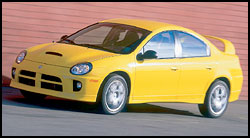 The
idea of something like the SRT-4 emerged three years ago when a small team
of Dodge engineers produced the SRT-4 concept car. It was a driver, too,
and it felt low, tight, powerful and fast when we drove it two years ago
at Irwindale Speedway. The production SRT-4 was unveiled to the public at
the Los Angeles auto show last January. Credit for that version goes to
Dodge’s Performance Vehicle Operations, the same group that made the
Viper SRT-10 and Viper GTS-R race car.
The
idea of something like the SRT-4 emerged three years ago when a small team
of Dodge engineers produced the SRT-4 concept car. It was a driver, too,
and it felt low, tight, powerful and fast when we drove it two years ago
at Irwindale Speedway. The production SRT-4 was unveiled to the public at
the Los Angeles auto show last January. Credit for that version goes to
Dodge’s Performance Vehicle Operations, the same group that made the
Viper SRT-10 and Viper GTS-R race car.So think of the SRT-4 as a Viper on an extraordinarily tight budget. How extraordinary? The sticker price is $19,995. You won’t see the name "Neon" anywhere near it (who knows why marketing people think the way they think?), but the SRT-4 is essentially a souped-up Neon.
|
2003 DODGE SRT-4 |
|
 Under the hood, the SRT-4 uses Dodge’s promising new 2.4-liter
turbocharged transverse-mounted four-cylinder engine, which also goes into
the much heavier Chrysler PT Turbo. That engine’s cast-iron block and
16-valve dohc aluminum head make 215 horsepower at 5200 rpm and a flat
torque peak of 245 lb-ft from 3200 to 4200 rpm. Redline is at 6240 rpm.
Engineers got all that power to the front wheels via a heavy-duty NVG T850
five-speed manual transaxle along with a high-capacity clutch and
equal-length halfshafts.
Under the hood, the SRT-4 uses Dodge’s promising new 2.4-liter
turbocharged transverse-mounted four-cylinder engine, which also goes into
the much heavier Chrysler PT Turbo. That engine’s cast-iron block and
16-valve dohc aluminum head make 215 horsepower at 5200 rpm and a flat
torque peak of 245 lb-ft from 3200 to 4200 rpm. Redline is at 6240 rpm.
Engineers got all that power to the front wheels via a heavy-duty NVG T850
five-speed manual transaxle along with a high-capacity clutch and
equal-length halfshafts.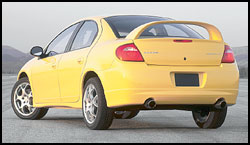 Springs, shocks, sway bars and even the steering knuckles were beefed up over the
stock Neon. Tires are 205/50R Michelin Pilots mounted on 17-inch rims. The
four-wheel disc brakes are bigger than stock both front and rear. The
hood, spoiler, skirts and rear wing are also unique and there are two big
racing seats with enough side bolsters to keep driver and passenger in
place on the most extreme performance runs. Yes, extreme.
Springs, shocks, sway bars and even the steering knuckles were beefed up over the
stock Neon. Tires are 205/50R Michelin Pilots mounted on 17-inch rims. The
four-wheel disc brakes are bigger than stock both front and rear. The
hood, spoiler, skirts and rear wing are also unique and there are two big
racing seats with enough side bolsters to keep driver and passenger in
place on the most extreme performance runs. Yes, extreme. With 215 hp pulling just 2970 pounds of curb weight, Dodge says the SRT-4 will go from 0 to 60 in 5.9 seconds and hit an electronically limited top speed of 148 mph."Our estimates show that this car will be the fastest in its class," said PVO vehicle synthesis engineer Jeff Reece.
That class includes the Honda Civic Si, Ford SVT Focus and Nissan Sentra SE-R Spec V (note that they’d exclude the 4wd Subaru WRX), among other sport compact racers. The aero body panels and wing aren’t just cosmetic, either. They all spent time in the wind tunnel, and consequently reduce the amount of lift front and rear compared to the stock Neon body, but do not eliminate it.
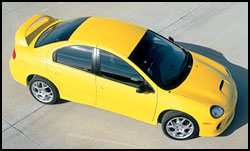 We took a prototype out for a few laps at the Streets of Willow, a short,
tight road course in the Southern California desert. The SRT-4 delivered
as promised, particularly in the power department. We have no reason to
doubt Dodge’s claimed 0-to-60 time of 5.9 seconds. The bigger brakes
never faded despite a late-summer ambient desert temperature of 104
degrees. Roll was minimized and very nicely controlled. It was a fun car
to drive at a racetrack, which is saying a lot. Once they get on a track,
most stock street cars show the roll and understeer that results from
suspensions set up for a smooth ride, and the brakes often start to fade
after a few hard laps. Not the case in the SRT-4.
We took a prototype out for a few laps at the Streets of Willow, a short,
tight road course in the Southern California desert. The SRT-4 delivered
as promised, particularly in the power department. We have no reason to
doubt Dodge’s claimed 0-to-60 time of 5.9 seconds. The bigger brakes
never faded despite a late-summer ambient desert temperature of 104
degrees. Roll was minimized and very nicely controlled. It was a fun car
to drive at a racetrack, which is saying a lot. Once they get on a track,
most stock street cars show the roll and understeer that results from
suspensions set up for a smooth ride, and the brakes often start to fade
after a few hard laps. Not the case in the SRT-4.There are a few things we would have done differently. There’s no limited-slip differential available, one of the compromises required to keep the price under 20 grand, but only autocrossers will likely notice that. We didn’t get any wheelspin from the inside drive wheel on our laps.
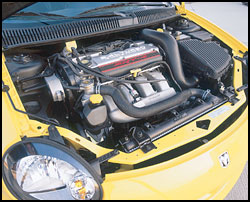 Another thing was the ride height, which was just that—high. The concept SRT-4
was much lower and had even less roll, faster cornering, and a much
stronger curbside appeal. However, the concept car didn’t have to pass
Dodge’s stringent durability tests for production cars, which include
"super-tortuous roads, with sin waves and potholes you wouldn’t
believe," said Reece. They ran a 24-hour durability test at Nelson
Ledges, too.
Another thing was the ride height, which was just that—high. The concept SRT-4
was much lower and had even less roll, faster cornering, and a much
stronger curbside appeal. However, the concept car didn’t have to pass
Dodge’s stringent durability tests for production cars, which include
"super-tortuous roads, with sin waves and potholes you wouldn’t
believe," said Reece. They ran a 24-hour durability test at Nelson
Ledges, too.While there are aftermarket springs available for the Neon, they won’t fit this application because of the unique steering knuckles. So you can’t lower it even if you wanted to, short of cutting the springs. We liked the look and feel of the concept SRT-4 better and we’d be willing to steer around those potholes and rain gutters to get them. We bet most buyers in this segment would, too.
While there are aftermarket springs available for the Neon, they won’t fit this application because of the unique steering knuckles. So you can’t lower it even if you wanted to, short of cutting the springs. We liked the look and feel of the concept SRT-4 better and we’d be willing to steer around those potholes and rain gutters to get them. We bet most buyers in this segment would, too.
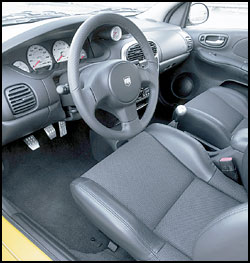 But we shouldn’t complain. That Dodge is willing to make such a
hyper-performance version of its least expensive car and make it
affordable is to be applauded. How did such a car ever make it through all
the shakeups that have rattled Chrysler in recent years?"Wolfgang
[Bernhard, chief operating officer of DaimlerChrysler] was head of AMG at
one point," said Reece. "He really has a soft spot for things
like this."
But we shouldn’t complain. That Dodge is willing to make such a
hyper-performance version of its least expensive car and make it
affordable is to be applauded. How did such a car ever make it through all
the shakeups that have rattled Chrysler in recent years?"Wolfgang
[Bernhard, chief operating officer of DaimlerChrysler] was head of AMG at
one point," said Reece. "He really has a soft spot for things
like this."Congratulations, Wolfgang. And the rest of the gang at PVO. We’re applauding.